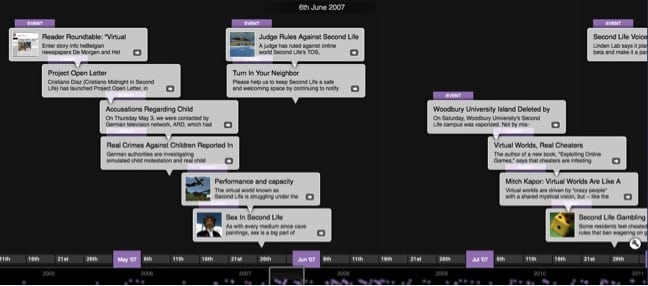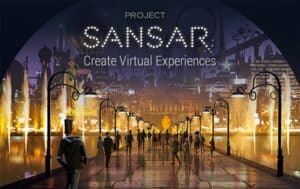The new immersive world by Linden Lab, creator of the well-known Second Life, came a little closer to reality this week. Project Sansar will now take “hundreds” of developer applications for a preview version of the platform. As Adi Robinson of The Verge points out,
While Second Life attracted many artists, modelers, and other people interested in its creative tools, it’s primarily remembered as something akin to a virtual social network. So far, Project Sansar has emphasized the creative side of things more heavily. We know it’s a place to build social spaces, but we’re not sure what interacting inside those spaces will look like. But the application does hint at what Linden Lab hopes people will do there — namely, absolutely everything, from health products to fashion.
From interviews with Ebbe Altberg, CEO of Linden Lab, it appears that Project Sansar will not be a self-contained world, but one that you step in and out of depending on your activities on the Web. It’s more like a version of WordPress for immersive experiences.
In a video interview with UploadVR last year, Altberg describes the Project:
Yeah it’s going to be, you can sort of call it a parallel universe, it’s going to be independent of Second Life, and it’s going to be less world-focused. Second Life is very much *a* world, where you enter the world and then you discover things within it. With Sansar we’ve taken more of a platform approach, where you don’t necessarily think of entering the world and then discovering things, you might discover things from outside: a search on Google, see a cool video on YouTube, whatever, which will lead you into any one particular experience. So every experience can attract it’s own audience. So that’s why we’ve referred to it’s similarities to WordPress. You don’t go to WordPress.com necessarily, you go to the blog, and that in the future instead of just being a blog it will be a virtual experience that you can enter. (Transcript quoted on Ciaran Laval)
Project Sansar will lower the barrier for creating content and Linden Lab will make money by taking a greater percentage of the exchange of content instead of selling the virtual space itself.
Of course it will be competing against a number of social VR projects including AltSpace, and former Linden Lab CEO Philip Rosedale’s own scalable, multi-user VR platform, High Fidelity.
Immersive Worlds and Educational Institutions

So far, early images from Project Sansar are beautiful, far surpassing the rudimentary graphics of Second Life. One intriguing question here is what will we build in our immersive worlds when we get access to them? And there’s an interesting lesson here from Second Life.
If you scroll back some years, many higher education institutions bought space in Second Life to create virtual campuses. Starting with a blank slate, most recreated the college campus and classroom as we find them in the real world – (virtual) classical stone buildings and classrooms with the instructor at the front of the room.
The virtual campuses often seemed to parallel what happened in early cinema – which not knowing what to do with a new media form simply replicated a earlier one (the theater stage).
Virtual reality opens an entirely new space with the freedom to do what we want. The question is: will we use that freedom to completely rethink learning or simply create the classroom that we’re trying so hard to reinvent in the real world?
Innovative tools are no guarantee of innovative results.
VR Scandals and Court Cases
Second Life taught us another lesson. The problems of the real world easily spill over to the virtual (and visa-versa). The platform had more than its share of scandals and legal issues generated by player activity. And what happened in SL may be just a hint of things to come as we begin to use new virtual reality platforms. Greater realism will bring a much greater legal morass.
If you’re interested, there’s a fascinating graphical timeline of the controversies surrounding Second Life at Tiki-Toki:

The Waiting Game
If you’re interested, you’ll have to wait as Project Sansar was originally scheduled to be out with Oculus Rift. We may see a beta version by the end of 2016. For now, the focus is on developing the platform for Oculus and HTC Vive. Mobile VR support will come later.
The possibilities are fascinating especially with the longterm goal of a mobile option. In the next year or two, we’re going to see a wide range of immersive platforms. Someday, we’ll look back and laugh at how Second Life was once the only game in town.

Emory Craig is a writer, speaker, and consultant specializing in virtual reality (VR) and artificial intelligence (AI) with a rich background in art, new media, and higher education. A sought-after speaker at international conferences, he shares his unique insights on innovation and collaborates with universities, nonprofits, businesses, and international organizations to develop transformative initiatives in XR, AI, and digital ethics. Passionate about harnessing the potential of cutting-edge technologies, he explores the ethical ramifications of blending the real with the virtual, sparking meaningful conversations about the future of human experience in an increasingly interconnected world.

